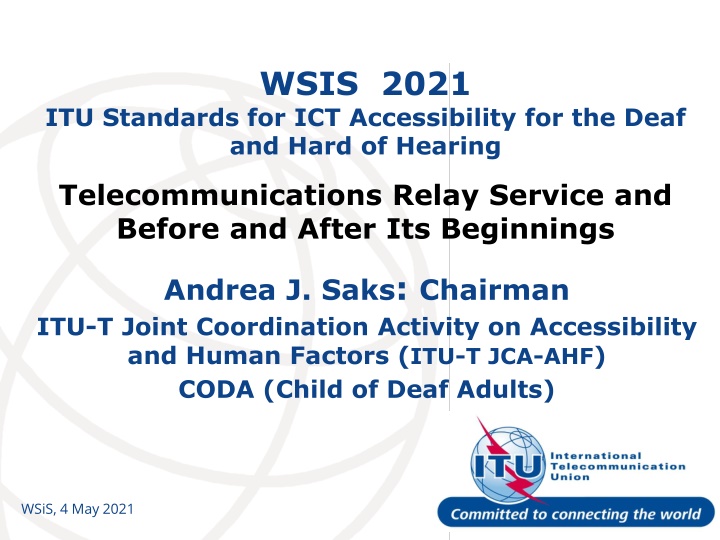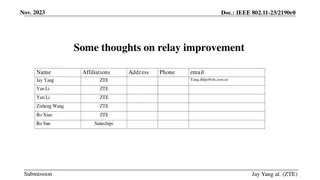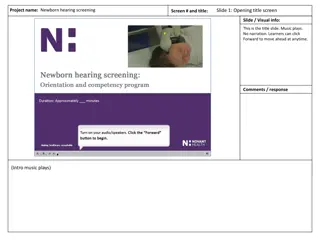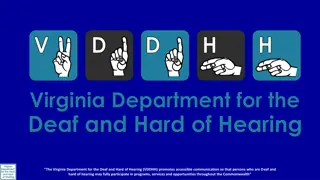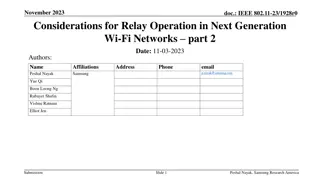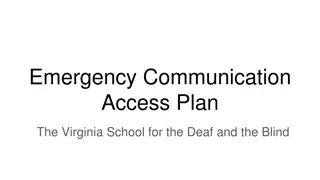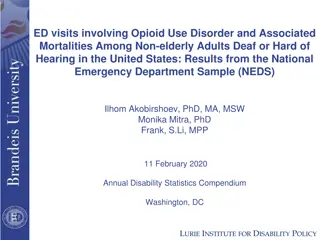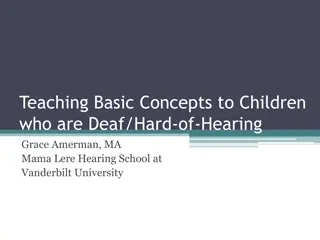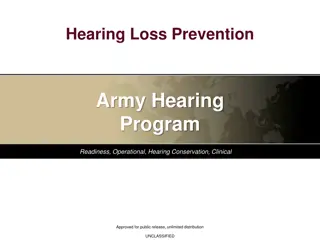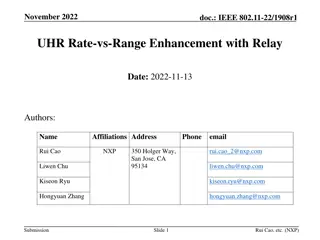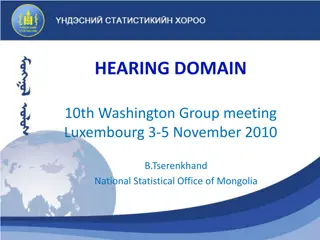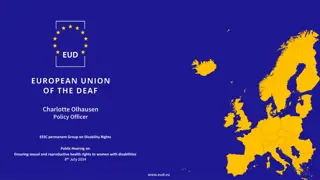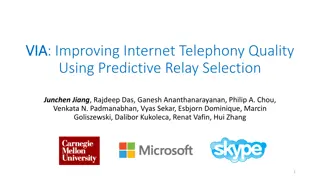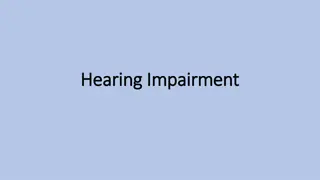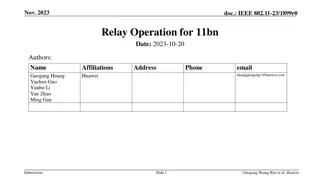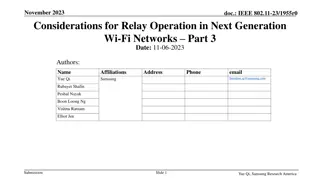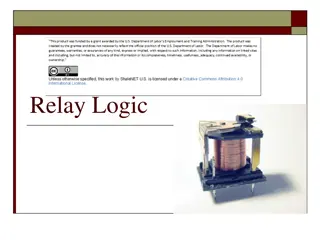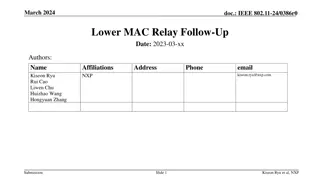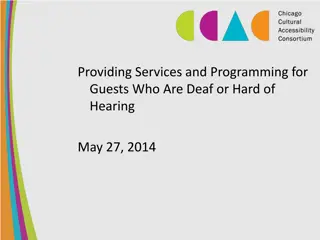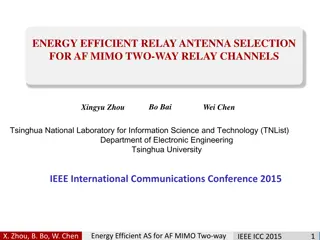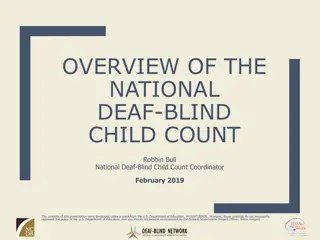Evolution of Relay Services for Deaf and Hard of Hearing Individuals
The history of relay services for the deaf and hard of hearing dates back to the 1960s in the USA. Three pioneering deaf men played a significant role in establishing the first successful deaf telephone network, leading to the development of relay services as we know them today. This evolution enabled deaf individuals to have a voice in political matters, ultimately changing the way they communicate and interact with the world.
Download Presentation

Please find below an Image/Link to download the presentation.
The content on the website is provided AS IS for your information and personal use only. It may not be sold, licensed, or shared on other websites without obtaining consent from the author.If you encounter any issues during the download, it is possible that the publisher has removed the file from their server.
You are allowed to download the files provided on this website for personal or commercial use, subject to the condition that they are used lawfully. All files are the property of their respective owners.
The content on the website is provided AS IS for your information and personal use only. It may not be sold, licensed, or shared on other websites without obtaining consent from the author.
E N D
Presentation Transcript
WSIS 2021 ITU Standards for ICT Accessibility for the Deaf and Hard of Hearing Telecommunications Relay Service and Before and After Its Beginnings Andrea J. Saks: Chairman ITU-T Joint Coordination Activity on Accessibility and Human Factors (ITU-T JCA-AHF) CODA (Child of Deaf Adults) WSiS, 4 May 2021
Why do we now need relay? When we have: Computers with video cameras Video phones email Mobile phones and SMS Pads/Tablets Instant messaging Let s go back to the very beginning of independence for Deaf people, the Mid 1960 s in the USA and see History. WSiS, 4 May 2021 2
Overview A Quick Historical View of events 1960 s the first USA Deaf Telephone Network starts with 5 stations, one with Grandma! For the Deaf by the Deaf working together reconditioning teleprinters/telex machines. TDI: Teletypewriters for the Deaf Inc. allowed to receive surplus telex machines. Compatibility without Standards so far so good as only in the USA. Beginning of 1973: The British Post Office gives permission for 5 Stations! WSiS, 4 May 2021 3
The Beginning Three Deaf Men Changed the World Robert Weitbrecht Andrew Saks James C Marsters Liberated the Telephone and that enabled deaf people to have a political voice that is now heard around the world! WSiS, 4 May 2021 4
A Historical View of events In the 1960 s they and their tiny company, Applied Communications Corporation (APCOM) created the first successful deaf telephone network with a modem and a surplus TTY. Surplus model 15 Phonetype acoustic coupler WSiS, 4 May 2021 5
USA: The first Deaf Telephone Network The Deaf created and made their system work themselves long before relay services started Photo: Sally A. Taylor wife of Paul Taylor founder of relay services pictured below Reconditioning teleprinters/telex machines donated to TDI Inc. It was by the Deaf for the Deaf working together with Western Union Volunteers and the Telephone Pioneers of America WSiS, 4 May 2021 6
The beginning of Relay Services The first idea with a normal answering service using two telephones and two textphones (TTY). Result? Andrew Saks ordering room service in a Hotel via TTY. Breakfast is served in New York but ordered from a California answering service. In the USA, Paul Taylor starts the First Relay Service, enabling many deaf people to subscribe and talk to hearing people in the early 70 s. All relay services have human beings as the interface. They are called CA s, Communication Assistants or Relay Service Operators. WSiS, 4 May 2021 7
The First Transatlantic Call 1975 Lord Jack Ashley (deaf) who was at the time a British MP Then USA Ambassador to the UK, Elliot Richardson with Michael Kingbeer a deaf engineer, looking on at US Trade Center Building in London to Washington D.C WSiS, 4 May 2021 8
First TTY Transatlantic Call 1975 when we had compatibility Due to anti-trust regulation, data was not allowed across the transatlantic voice network. FCC waived the rule for this call for one day only. What it meant to USA and UK Deaf people could talk (text) over the trans-Atlantic- voice telephone network, using data or i.e. text long before email or SMS. Faxing across the transatlantic network was now legal because of the Deaf, by proving that data was personal communication. We thought we were going to be international. Sadly it was broken by UK misguided by the new! WSiS, 4 May 2021 9
The beginning at ITU: 1991 Gary Fereno, US State Department & AJS No personal computers just lots of paper! WSiS, 4 May 2021 10
Types of Relay Services Text Relay Service using a typing device, with or without VCO (voice carry over) and often called TRS as the T stood for TEXT. Video Relay Service for sign language with facial expressions and some lip reading. CapTel/Web CapTel Relay: the user with his own voice, speaking directly (VCO) to whom he calling but receiving reply in text so no need to type. This is transparent! Speech to Speech Relay for those who may have hearing but speak with difficulty. WSiS, 4 May 2021 11
For those wish to use their Voice Captel Relay device for speaking and receiving text for people who wish to speak speak directly to whom they are calling. It is a transparent Process. WSiS, 4 May 2021 12
Video Phone Video phone for signing and voice without text How many hearing People have them? Used with VRS and direct Calls WSiS, 4 May 2021 13
Why People need relay Services Relay Services connect people to the hearing world in real time. Establishing independence & not having to rely on children, family, friends or strangers. A personal private phone call with a doctor, lawyer or their child s teacher via a relay. Everyone answers the phone in real time. Email, instant messaging and SMS not real time and not reliable for real time tasks. Jobs and Education changes with Relay. Relay Services connect people to Real Life! WSiS, 4 May 2021 14
Why People need Relay on the Go In the USA some Relay providers use apps for Mobile phones. Some use Android platforms others use Apple based apps for relay on the move. Portability for Relay Services in real time for real time situations. One major category of importance is real time emergency serivces WSiS, 4 May 2021 15
Who needs Relay Services? Deaf People and Hard of Hearing People People who use sign language with or without speech and there are as many sign languages as countries on the planet if not more. Some deaf people do not sign or who are in a country where they do not know the sign. People who are deafened later life either medically or through age and who mostly likely do not sign and most can speak. People who have severe hearing impairment but can speak and do not sign. 1. 2. 3. 4. WSiS, 4 May 2021 16
Who needs Relay Services? Deaf Blind People There are no two people alike. It is not total darkness and total silence. It is possible to use Text Relay Services and Video Relay services with assistive technology. Famous deaf/blind Helen Keller could speak. People with Voice impairments Specially trained communication assistants or relay operators who listen and can understand distorted voices and speak for people who wouldn t otherwise be understood. 1. 2. 3. 4. 1. WSiS, 4 May 2021 17
Embracing total conversation A deaf-blind woman uses multimedia communication (ITU-T F.703 service description): She uses sign-language She receives text Also for emergency services (Outreach 112) DeafBlind Telecom.jpg Voice, video, text relay refreshable Braille device WSiS, 4 May 2021 18
Older Text Phones still needed Portable Textphones that the deaf blind still use because of Light emitting diode. These are both Ultratec Textphone products and (now usable with mobile phones) Other companies follow some deaf owned make Hard copy Compacts often dual coded (photos: Ultratec) WSiS, 4 May 2021 19
What is next to Discuss ? Future Global inclusion Standards: Every relay service should be international like the hearing phone. How we presently access relay services International numbering for access. Who should pay and equivalent service under article 9 of the UNCRPD. ITU s involvement and inclusive Policy. WSiS, 4 May 2021 20
Why promote and create accessible ICTs, Assistive Technology and International Relay Services? It is a human right recognized in the UN Convention on the Rights of Persons with Disabilities (UNCRPD):Enshrined in Article 9 Article 9 of the UNCRPD defines ICT accessibility as an integral part of accessibility rights on par with transportation and the physical environment. Article 9 concerns all ICT products and ICT based applications and services, with a far-reaching implication for industry, governments and civil society All of us who age will have age-related disabilities, We all (100%) can benefit from more accessible devices and services. We will need relay services. WSiS, 4 May 2021 21
We Need Persons with Disabilities to play a part in society Relay Services need strong non-proprietary International Standards for transparent international access Simple international numbering for usage globally so that any person with disabilities can access them anywhere in the world All countries and relay services providers are invited participate in the work of Q26/ Study Group 16 Mobile phones and pads should be included There needs to be easy access to relay services with simple short numbers Q4/ Study Group 2 Interoperability and access, Global connectivity in all countries to enable all to be a part of society. XVIII World Congress, WFD, Paris, 23-27 July 2019 22
New Standards Need Persons with Disabilities to Participate Engineers and standard writers need Disability scenarios from the very people who require the accessibility features to write good Standards New Standards need industry assistance and implementation for globalization and PWD s in put Persons with disabilities now participate in person or remotely with captioning and sign language in the ITU standards processes. ITU-T in Q26/16 is working on two technical papers for relay services with the participation of PWDs WSiS, 4 May 2021 23
Persons with Disabilities Created their own Deaf Telephone Network They want International Access that is transparent They must be involved and their needs listen to. Their participation and creativity in the past must be regarded with respect. Their experience must be respected. XVIII World Congress, WFD, Paris, 23-27 July 2019 24
Real Time text conversation User A User B Why do you need character by character transmission? Because then you get a live conversation suitable for a real time call. Yes, I see, I can read your thoughts at the moment you express them. No waiting. Good!
Without International Standards there cannot be Accessibility for Persons with Disabilities Without the involvement of Persons with Disabilities in the standardization process, it will be more difficult to create good Relay Services that actually work. Without Universal Design being used from the very beginning of the standard writing process, implementation becomes expensive with retro refitting. WSiS, 4 May 2021 26
Standardizing Relay Services ITU-T F.930 (03/2018) - Multimedia telecommunication relay services SG 16 the lead Study Group in accessibility Q26/16 leading the work in Relay Services and Guidelines for PWDs Relay Service Providers participating in the work and welcome and needed Standard Writers Participating in many other questions that apply to Relay WSiS, 4 May 2021 27
Final Message Accessibility difficulty is expressed everyday with new barriers that are being created by new technology especially those with proprietary standards. Countries unfortunately practice Not invented Here! Relays need Gateways or Session Border Controllers to be updated to have international interoperability. If industry, all standards organizations and regulators will work together, then it is possible to have globalized Accessible ICTs, Telecommunications, and transparent accessible International Relays. People need relays to have full lives for work, family, friends, education and to contribute back to society and in real time. WSiS, 4 May 2021 28
Contact Andrea J. Saks Chairman, ITU-T Joint Coordination Activity on Accessibility and Human Factors, (JCA-AHF) ) TDI Representative to ITU (website) G3ict Representative to ITU http://g3ict.org/about/management Accessibility Advisor to USA delegations attending ITU-T and ITU-D Study Groups. E-mail: Andrea@andreasaks.onmicrosoft.com WSiS, 4 May 2021 29
